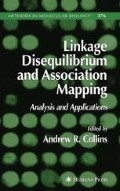Abstract
Over the last few years, association mapping of disease genes has developed into one of the most dynamic research areas of human genetics. It focuses on identifying functional polymorphisms that predispose to complex diseases. Population-based approaches are concerned with exploiting linkage disequilibrium (LD) between single-nucleotide polymorphism (SNPs) and disease-predisposing loci. The utility of SNPs in association mapping is now well established and the interest in this field has been escalated by the discovery of millions of SNPs across the genome. This chapter reviews an association-mapping method that utilizes metric LD maps in LD units and employs a composite likelihood approach to combine information from all single SNP tests. It applies a model that incorporates a parameter for the location of the causal polymorphism. A proof-of-principle application of this method to a small region is given and its potential properties to large-scale datasets are discussed.
Access this chapter
Tax calculation will be finalised at checkout
Purchases are for personal use only
References
Botstein, D. and Risch, N. (2003) Discovering genotypes underlying human phenotypes: past successes for mendelian disease, future approaches for complex disease. Nat. Genet. 33, 228–237.
Maniatis, N., Collins, A., Xu, C. F., et al. (2002) The first linkage disequilibrium (LD) maps: delineation of hot and cold blocks by diplotype analysis. Proc. Natl. Acad. Sci. USA 99, 2228–2233.
Collins, A. and Morton, N. E. (1998) Mapping a disease locus by allelic association. Proc. Natl. Acad. Sci. USA 95, 1741–1745.
Morton, N. E., Zhang, W., Taillon-Miller, P., Ennis, S., Kwok, P. Y., and Collins, A. (2001) The optimal measure of allelic association. Proc. Natl. Acad. Sci. USA 98, 5217–5221.
Malecot, G. (1948) Les Mathématiques de l’Hérédité. Maison et Cie, Paris, France.
Morton, N. E. (2002) Applications and extensions of Malecot’s work in human genetics. In: Modern Developments in Theoretical Population Genetics, (Slatkin, M. and Veuille, M., eds.), Oxford University Press, Oxford, UK.
Zhang, W., Collins, A., Maniatis, N., Tapper, W., and Morton, N. E. (2002) Properties of linkage disequilibrium (LD) maps. Proc. Natl. Acad. Sci. USA 99, 17,004–17,007.
Jeffreys, A. J., Kauppi, L., and Neumann, R. (2001) Intensely punctate meiotic recombination in the class II region of the major histocompatibility complex. Nat. Genet. 29, 217–222.
Tapper, W., Collins, A., Gibson, J., Maniatis, N., Ennis, S., and Morton, N. E. (2005) A map of the human genome in linkage disequilibrium units. Proc. Natl. Acad. Sci. USA 102, 11,835–11,839.
Maniatis, N., Collins, A., Gibson, J., Zhang, W., Tapper, W., and Morton, N. E. (2004) Positional cloning by linkage disequilibrium. Am. J. Hum. Genet. 74, 846–855.
Daly, M. J., Rioux, J. D., Schaffner, S. F., Hudson, T. J., and Lander, E. S. (2001) High-resolution haplotype structure in the human genome. Nat. Genet. 29, 229–232.
Devlin, B., Risch, N., and Roeder, K. (1996) Disequilibrium mapping: composite likelihood for pairwise disequilibrium. Genomics 36, 1–16.
Maniatis, N., Morton, N. E., Gibson, J., Xu, C. F., Hosking, L. K., and Collins, A. (2005) The optimal measure of linkage disequilibrium reduces error in association mapping of affection status. Hum. Mol. Genet. 14, 145–153.
Maniatis, N., Collins, A., and Morton, N. (2006) Effects of single SNPs, haplotypes, and whole Genome LD Maps on accuracy of association mapping. Submitted.
Zhang, W., Maniatis, N., Rodriguez, S., et al. (2006) Refined association mapping of a causal site for a quantitative trait: weight in the H19-IGF2-INS-TH region. Ann. Hum. Genet., in press.
Dobson, A. J. (1986) An Introduction to Statistical Modelling. Chapman and Hall, University Press, Cambridge, UK.
Hosking, L. K., Boyd, P. R., Xu, C. F., et al. (2002) Linkage disequilibrium mapping identifies a 390 kb region associated with CYP2D6 poor drug metabolising activity. Pharmacogenomics J. 2, 165–175.
Salem, R. M., Wessel, J., and Schork, N. J. (2005) A comprehensive literature review of haplotyping software and methods for use with unrelated individuals. Hum. Genomics 2, 39–66.
Hill, W. G. (1974) Estimation of linkage disequilibrium in randomly mating populations. Heredity 33, 229–239.
Gabriel, S. B., Schaffner, S. F., Nguyen, H., et al. (2002) The structure of haplotype blocks in the human genome. Science 296, 2225–2229.
Clark, A. G. (2004) The role of haplotypes in candidate gene studies. Genet. Epidemiol. 27, 321–333.
Morris, A. P. (2005) Direct analysis of unphased SNP genotype data in population-based association studies via Bayesian partition modelling of haplotypes. Genet. Epidemiol. 29, 91–107.
Lin, S., Chakravarti, A., and Cutler, D. J. (2004) Exhaustive allelic transmission disequilibrium tests as a new approach to genome-wide association studies. Nat. Genet. 36, 1181–1188.
Klein, R. J., Zeiss, C., Chew, E. Y., et al. (2005) Complement factor H polymorphism in age-related macular degeneration. Science 308, 385–389.
Risch, N. and Merikangas, K. (1996) The future of genetic studies of complex human diseases. Science 273, 1516–1517.
International HapMap Consortium (2003) The International HapMap Project. Nature 426, 789–796.
Author information
Authors and Affiliations
Editor information
Editors and Affiliations
Rights and permissions
Copyright information
© 2007 Humana Press Inc.
About this protocol
Cite this protocol
Maniatis, N. (2007). Linkage Disequilibrium Maps and Disease-Association Mapping. In: Collins, A.R. (eds) Linkage Disequilibrium and Association Mapping. Methods in Molecular Biology™, vol 376. Humana Press. https://doi.org/10.1007/978-1-59745-389-9_8
Download citation
DOI: https://doi.org/10.1007/978-1-59745-389-9_8
Publisher Name: Humana Press
Print ISBN: 978-1-58829-669-6
Online ISBN: 978-1-59745-389-9
eBook Packages: Springer Protocols

